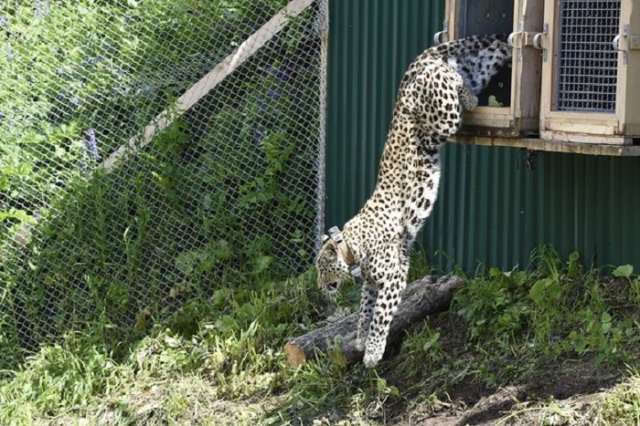Rare leopards released into Russian reserve threatened by a ski resort

The new reintroduction plan was intended to lay the foundation for a new population of the charismatic big cats, which are now thought to number less than 500 across central Asia.
But conservationists say that a recent vote in the Russian parliament to weaken environmental protections, and allow new ski trail constructions in Sochi, will cut off a vital corridor to Turkmenistan for the free-roaming animals.
Igor Chestin, the CEO of WWF Russia said: “We had hoped to release these very special leopards into a secure environment. Instead they will enter the unknown. The future of the western Caucasus is hanging in the balance.”
At a conference in Istanbul on Thursday, the world conservation body, Unesco, warned that the Russian parliament’s vote could have “negative impacts” on the Persian leopards’ reintroduction.
Construction of large scale infrastructure on the site could lead to its being placed on the list of world heritage sites in danger, the committee agreed. But it declined to do so immediately, despite pleas from conservationists.
WWF Russia says it wants the International Olympic Committee to be more proactive in pressuring Russia to honour environmental promises made at the time of the 2014 winter games in Sochi.
At the time, Russia pledged to expand two protection areas around the world heritage site. Last week however, Russia’s president, Vladimir Putin, signed off an amendment to allow new ski constructions within the site itself.
The original ground-breaking plan to bring the endangered leopard species back from the dead envisaged 100 big cats returning to the region’s forests and mountains.
These would have followed traditional migratory routes to mate with female cats in Azerbaijan, Armenia, and Georgia. If the ski resorts are built as planned though, no more than 30-40 big cats will establish themselves in the western Caucasus, Chestin said.
“The development of ski resorts will destroy the connectivity of the protected area between the central and western Caucasus where leopards are still occasionally observed,” he told the Guardian. “A few dozen animals may be able to live there, but it would be a deadlocked development.”
The Russian leopard breeding programme used cats donated by Iran – which houses the world’s largest remaining population – as well as from Turkmenistan, and Portugal.
Cubs born in the project’s state of the art reintroduction and rehabilitation centre spent a year in captivity with their mother. “It was more important and difficult to develop avoidance of contact with humans than the ability to hunt,” Chestin said.
The cubs were only released once they had learned to hunt food for themselves
Facebook Twitter Pinterest
The cubs were only released once they had learned to hunt food for themselves. Photograph: WWF
The cubs were then separated and put into large 100 sq metre enclosures, where they started to be fed with live animals to learn how to kill. First they were given domestic animals, then wild ones.
“When they started to kill animals the size of a deer we assumed they were ready to live on their own in the wild,” Chestin said. “All the animals released today passed the test with excellent results.”
The three animals now reorienting themselves to their ancestral hunting ground – a female called Victoria, and two males named Akhun and Kili – are between two and three years old.
More leopards are expected to be released to the Alpine region, 30m east of Sochi, in 2018.















































